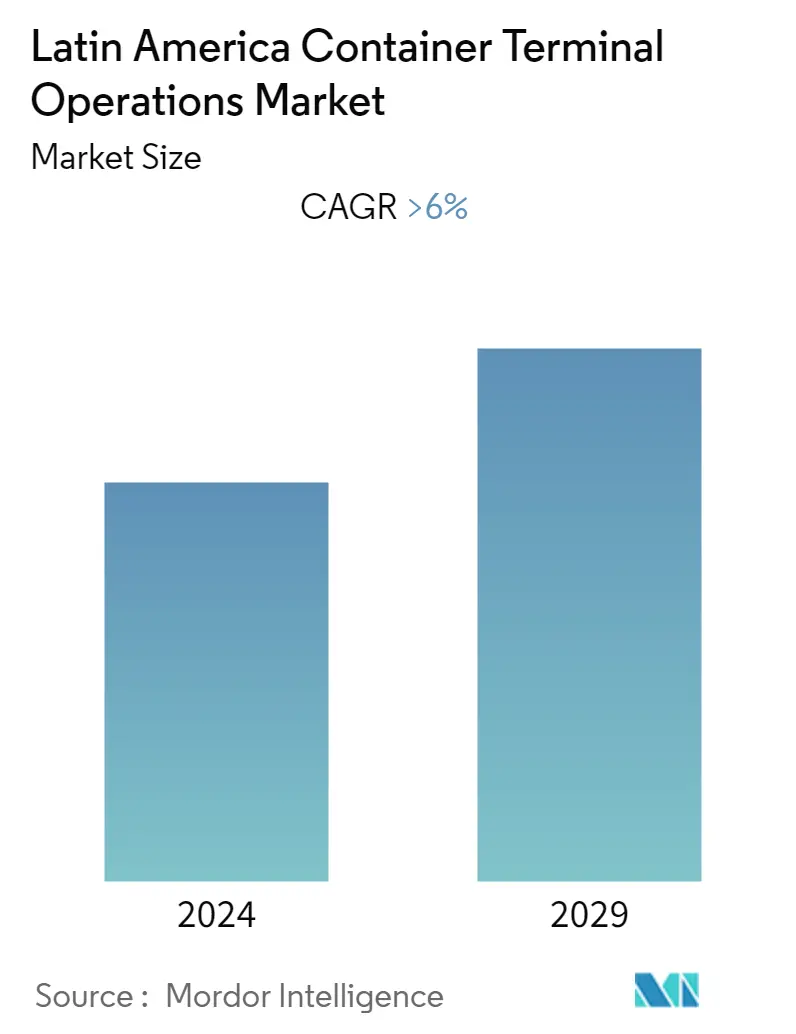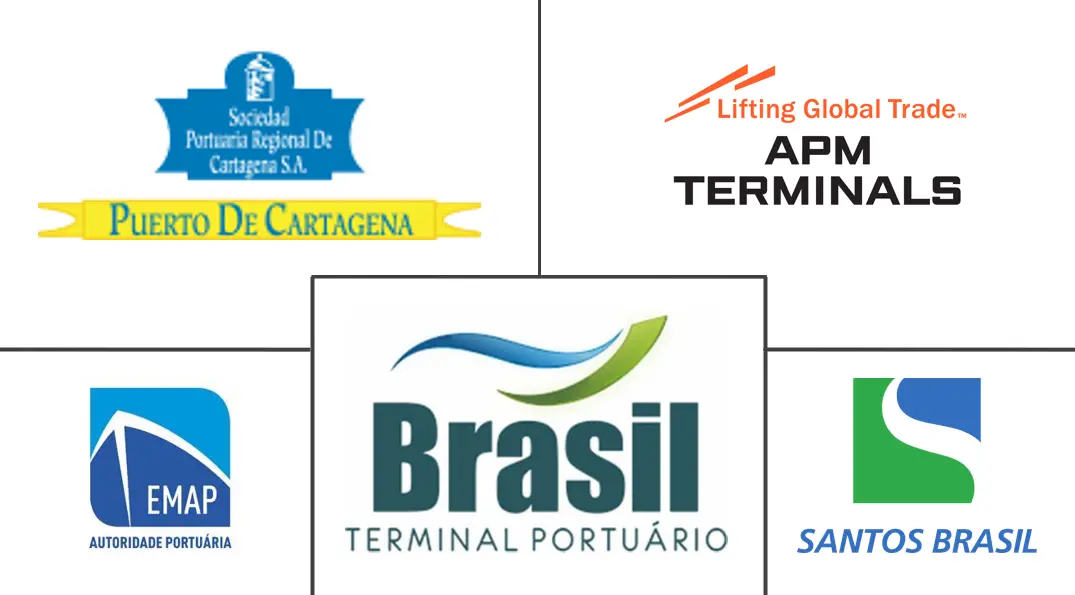Market Size of Latin America Container Terminal Operations Industry

| Study Period | 2020 - 2029 |
| Base Year For Estimation | 2023 |
| Forecast Data Period | 2024 - 2029 |
| Historical Data Period | 2020 - 2022 |
| CAGR | 6.00 % |
| Market Concentration | Medium |
Major Players
*Disclaimer: Major Players sorted in no particular order |
Latin America Container Terminal Operations Market Analysis
The size of Latin America Container Terminal Operations market is USD 1.7 billion in the current year and is anticipated to register a CAGR of over 6% during the forecast period.
- The supply chain in the maritime industry has been facing a series of challenges since the start of the COVID-19 pandemic in early 2020. Port closures due to coronavirus outbreaks, port congestions, rising prices of bunker fuel, and problems with capacity utilization were plaguing the marine port services industry for most of 2020 and 2021. Due to the pandemic, the volume of containers transported shrank by about 0.2 percent in 2020. On the other hand, the recent spike in container freight rates turned out extremely profitable for marine port services operators, who reported record-high profit margins in 2021.
- Container terminal services are very complex and mainly depend upon the nature of shipment and cargo. Cargo can be anything cars, merchandise, crude oil, mineral, and other types.
- The evolution of supply chains and logistics models has caused container terminals to rethink their logistics processes. The concept of ports and their functions have evolved over the decades.
- A different set of machinery, expertise, and workforce is required to handle and manage other types of cargo. The ferry services require different types of ports for their handling. The lack of efficiency in operations at the container terminal is not desirable and can also lead to accidents. So the container terminal operations should be highly efficient and flawless. Therefore container terminal operations are the core of the maritime industry.
- With the advent of digital technology, ports have become more automated, interconnected supply chains, and limited workforce to perform operations. As a result, various investments are being made in port automation to increase port efficiency.
- New technology companies are poised to transform South America's shipping and freight industry. Startups like Newport's, a Mexican freight shipping startup, are angling to be the next Convoy and Flexport - when the shipping and logistics business in South America is booming thanks to increasing trade from China.
- South American countries are observing an increasing number of international companies entering and expanding in the region to take advantage of the growing opportunities.
- The expansion of the Panama Canal has inspired the development of ports in the Latin America and the Caribbean (LAC) region, seeking to capitalize on economic opportunities through maritime trade.
Latin America Container Terminal Operations Industry Segmentation
Container Terminal Operation and Cargo Handling Container terminals are designated for the handling, storage, and possibly loading or unloading of cargo into or out of containers, and where containers can be picked up, dropped off, maintained, stored, or loaded or unloaded from one mode of transport to another (that is, vessel, truck, barge, or rail). A container terminal's main activity is transferring cargo units from one transport modality to another.
The Latin America Container Terminal Operations Market is segmented By Service (Stevedoring, Cargo Handling & Transportation, and Others), By Cargo Type (Dry Cargo, Crude Oil, and Other Liquid Cargo). The report offers market size and forecasts for the Latin America Container Terminal Operations market in value (USD billion) for all the above segments.
| By Service | |
| Stevedoring | |
| Cargo Handling & Transportation | |
| Others |
| By Cargo Type | |
| Crude Oil | |
| Dry Cargo | |
| Other Liquid Cargo |
Latin America Container Terminal Operations Market Size Summary
The Latin America Container Terminal Operations market is experiencing a dynamic phase, driven by the evolution of supply chains and logistics models. The industry has faced significant challenges due to the COVID-19 pandemic, including port closures, congestion, and rising fuel costs, which impacted container transport volumes. However, the subsequent increase in container freight rates has led to record profit margins for marine port service operators. The sector is witnessing a transformation with the integration of digital technologies and automation, enhancing port efficiency and interconnectivity. This technological advancement is attracting investments and fostering the emergence of startups aiming to revolutionize the shipping and freight industry in South America. The expansion of the Panama Canal has further stimulated port development in the region, positioning Latin America as a crucial player in global maritime trade.
The market landscape is characterized by a mix of local and international players, contributing to its fragmented nature. Key ports such as the Port of Colon in Panama and the Port of Santos in Brazil are pivotal to the region's trade, handling substantial cargo volumes and serving as major trade routes. The private sector's involvement has significantly boosted operational efficiency and productivity, making Latin American and Caribbean ports more competitive. The region's strategic location, coupled with the Panama Canal's expansion, has enhanced its role in global trade, facilitating increased cargo tonnage and shipping activity. As the market continues to grow, driven by both technological advancements and strategic investments, it is expected to maintain a positive trajectory in the coming years.
Latin America Container Terminal Operations Market Size - Table of Contents
-
1. MARKET INSIGHTS AND DYNAMICS
-
1.1 Market Overview
-
1.2 Market Drivers
-
1.3 Market Restraints
-
1.4 Market Opportunities
-
1.5 Industry Attractiveness - Porter's Five Forces Analysis
-
1.5.1 Threat of New Entrants
-
1.5.2 Bargaining Power of Buyers/Consumers
-
1.5.3 Bargaining Power of Suppliers
-
1.5.4 Threat of Substitute Products
-
1.5.5 Intensity of Competitive Rivalry
-
-
1.6 Government Initiatives and Regulations
-
1.7 Value Chain / Supply Chain Analysis
-
1.8 Technological Advancements In The Market
-
1.9 Impact of Covid-19 on the Market
-
-
2. MARKET SEGMENTATION
-
2.1 By Service
-
2.1.1 Stevedoring
-
2.1.2 Cargo Handling & Transportation
-
2.1.3 Others
-
-
2.2 By Cargo Type
-
2.2.1 Crude Oil
-
2.2.2 Dry Cargo
-
2.2.3 Other Liquid Cargo
-
-
Latin America Container Terminal Operations Market Size FAQs
What is the current Latin America Container Terminal Operations Market size?
The Latin America Container Terminal Operations Market is projected to register a CAGR of greater than 6% during the forecast period (2024-2029)
Who are the key players in Latin America Container Terminal Operations Market?
Brasil Terminal Portuário S.A., Santos Brasil Participacoes S/A, Maranhense Port Administration Company (EMAP)., APM Terminals Callao and The Port of Cartagena Organization are the major companies operating in the Latin America Container Terminal Operations Market.

